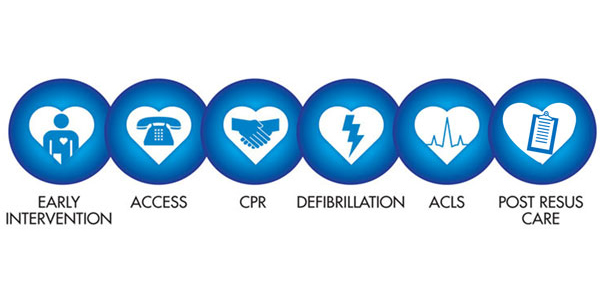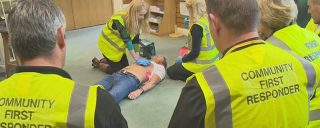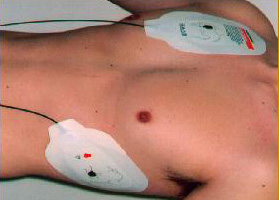CFR Ireland
How to use a defibrillator
CFR Ireland
AEDs (Automatic External Defibrillators)
When used within the first 3-5 minutes of a person suffering a Sudden Cardiac Arrest (SCA) can dramatically increase a victims chance of survival from currently what is currently less 5% to as much as 70% and higher with a defibrillator on the scene. AEDs were designed to be used by virtually anyone with little or no experience.
An AED will automatically analyse the heart rhythm of a pulse less victim and, if the victim is in ventricular fibrillation (VF) or ventricular tachycardia (VT), shock the victim’s heart in an attempt to restore its rhythm to normal. AEDs will not shock patients who do not require a shock.
When a heart is in VF, it is still receiving nerve impulses from the brain. These impulses are simply firing so chaotically that the heart cannot produce a “beat;” it cannot expel enough blood to keep the circulatory system flowing through the body. Brain cells begin to die after 4-6 minutes of oxygen deprivation.
The heart will continue its uncoordinated twitching or fluttering until it is no longer receiving electrical impulses from the brain and thus stops all together, or until the heart is shocked back into a normal rhythm, which is where an AED comes in. An AED stops the heart from its spasm by shocking it. This allows the nerve impulses a chance to resume their normal pattern, which, in turn, allows the heart to resume beating at its normal pace.
The ONLY definitive treatment for ventricular fibrillation (VF) is DE -FIBRILLATION

Step by step use of an AED
The AED will guide you through the entire process until help has arrived.
Follow the visual & voice prompts of the AED
1. Call 999 or 112.
If you see someone collapse, immediately call 000 and get the paramedics en route. If there are other people around, choose someone specific and instruct them to call 999 or 112 and explain the situation. This decreases confusion about who should do what and ensures that the call is being placed.
2. Check the victim’s breathing and airway.
If someone has collapsed, you should immediately determine whether they are breathing. If the victim is breathing, you know that they have a pulse. If the victim is not breathing, check the airway is clear then begin CPR at 2 breaths then 30 chest compressions at a depth of 4-5cm.
3. Locate an AED.
If there is an AED nearby, ask a bystander to take over CPR while you apply the AED chest electrode pads to the victim. Uninterrupted CPR is an important factor in increasing the recovery rate of cardiac arrest patients. Always ensure that someone is providing CPR for the victim unless the AED machine is actively analysing or shocking the victim.
4. Turn on the AED.
Follow the visual & voice prompts of the AED
5. Attach the electrode pads to patients bare chest. (Expose the patients bare chest, male or female)
First ensure that the adhesive AED pads are attached to a cable, which is plugged into the AED machine. Then bare the victim’s chest including females and attach the adhesive AED pads in the appropriate locations. The AED should include a diagram (typically on the adhesive pads themselves) indicating where each pad goes.
6. Always follow the instructions of the AED.
Note: CPR should not be interrupted while the adhesive electrode pads are being applied.

Services
Contact

Male Electrode Pads
Two Piece Pads Position
CFR Ireland
ABOUT CFR
Founded
Number of Groups
Number of Volunteers
AED Registered
CFR Ireland
JOIN OUR NEWSLETTER
